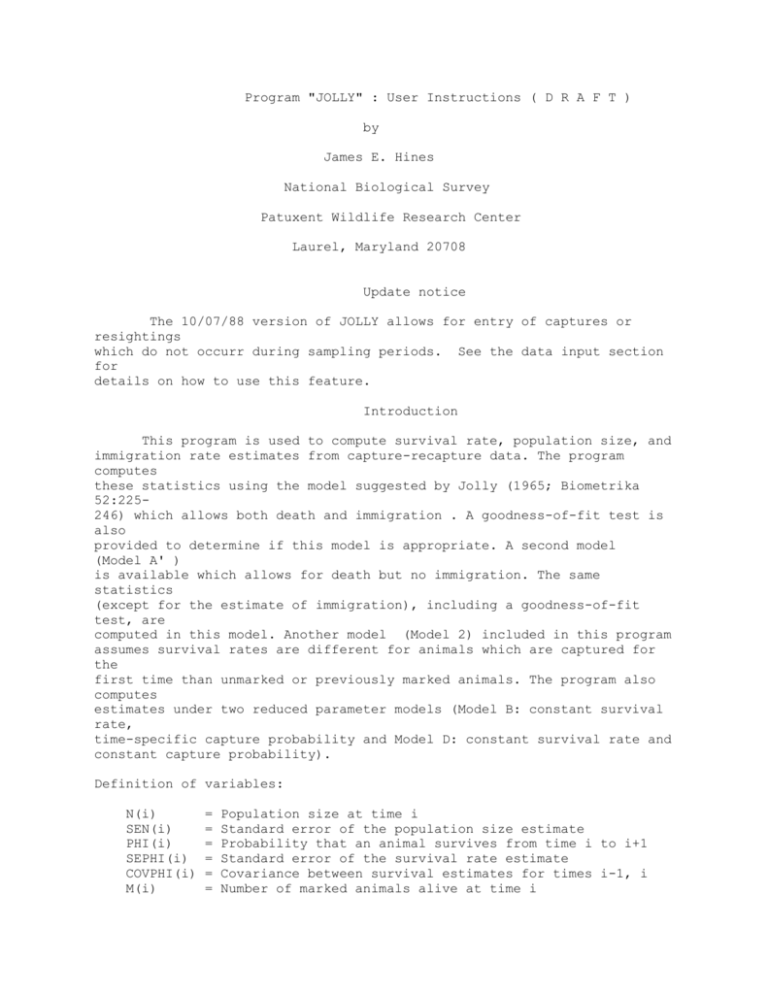Program "JOLLY" : User Instructions ( D R A F T ) by James E. Hines
advertisement

Program "JOLLY" : User Instructions ( D R A F T ) by James E. Hines National Biological Survey Patuxent Wildlife Research Center Laurel, Maryland 20708 Update notice The 10/07/88 version of JOLLY allows for entry of captures or resightings which do not occurr during sampling periods. See the data input section for details on how to use this feature. Introduction This program is used to compute survival rate, population size, and immigration rate estimates from capture-recapture data. The program computes these statistics using the model suggested by Jolly (1965; Biometrika 52:225246) which allows both death and immigration . A goodness-of-fit test is also provided to determine if this model is appropriate. A second model (Model A' ) is available which allows for death but no immigration. The same statistics (except for the estimate of immigration), including a goodness-of-fit test, are computed in this model. Another model (Model 2) included in this program assumes survival rates are different for animals which are captured for the first time than unmarked or previously marked animals. The program also computes estimates under two reduced parameter models (Model B: constant survival rate, time-specific capture probability and Model D: constant survival rate and constant capture probability). Definition of variables: N(i) SEN(i) PHI(i) SEPHI(i) COVPHI(i) M(i) = = = = = = Population size at time i Standard error of the population size estimate Probability that an animal survives from time i to i+1 Standard error of the survival rate estimate Covariance between survival estimates for times i-1, i Number of marked animals alive at time i p(i) B(i) SEB(i) = Probability that an animal alive at time i is captured in the i-th sample = Number of new animals recruited during the interval i to i+1, and alive at time i+1 = Standard error of the recruitment estimate Data input: The input file for program JOLLY must contain some control records, followed by the data records. The control records are used to tell the program the title of the data, number of capture periods, interval lengths and data type. The format of the control records is: PARAMETER=value Only one program parameter may be set on each record and the equal sign is required. No spaces may be entered on the right of the equal sign except in the TITLE record. The following are example control records: TITLE=Sample data for program JOLLY NUMBER OF PERIODS=12 FIRST=1966 DATA TYPE=B-TABLE INTERVALS=1,1,1,2,2,1,1,1,1,1,1 The data records may be in one of three forms. The default is capturehistory record format type. The other types of input data are "CAP/REL HISTORY RECORDS" and "B-TABLE". Capture history records are strings of zero's, one's and two's to indicate or not an animal was captured and released in each time period. One record is entered for each animal banded in the experiment. Each column contains a one if the animal was captured and released i the sampling period. If the animal was not captured in the period, a zero is entered in the column corresponding to that period. Occasionally, animals are killed in the traps and not released back into the population. In this case, a two is entered in the column to indicate capture but not released. ----------------------------------------------------------------------------*** In the 10/07/88 version of JOLLY, two more catagories for the capturehistory record have been added. When an animal is not captured in sample i but was captured(or resighted) between samples i and i+1, a three is entered in the column corresponding to sample i. If an animals is captured in sample i, and caught between samples i and i+1, a four is entered in the column corresponding to sample i. ----------------------------------------------------------------------------To reduce the amount of input, a weighting variable is read in at the end of each capture-history record. This variable indicates the number of animals which the capture-history represents. IMPORTANT: Even if you do not enter anything for this weighting variable, it must be accounted for in the format! (ie. If you have x time periods, the format must allow for x+1 variables.) IMPORTANT-2: Do not enter a weight of zero for summarized capture-history data. The program will assume there was one individual with this capturehistory. (Just omit these capture-history records from the file.) Example 1 (Capture-history record format): record 1 |TITLE=JOLLY TEST DATA SET USING THE CAP-HISTORY INPUT FORMAT 2 |NUMBER OF PERIODS=5 3 |FIRST=1961 4 |INTERVALS=0.5,0.1,0.2,0.3 5 |FORMAT=(1X,5(2X,I1),I3) 6 | 0 0 0 1 1 5 7 | 0 1 0 1 0 12 8 | 1 0 2 0 0 1 9 | 0 0 0 0 1 20 10 | 3 4 0 0 1 2 Explanation: Record 1 - Title of the data set. Record 2 - Number of trapping periods = 5, Record 3 - 1961 = first trapping period Record 4 - Number of units (days, months, or years) between each of the capture periods. Record 5 - FORTRAN format of recapture records. Records 6-9 : 1 = Captured and released, 2 = Captured and not released, 0 = Not captured. Record 6 - Five animals were captured and released in samples 4 and 5, and not captured in samples 1,2, and 3. The "5" in the last column specifies that 5 individuals had this capturehistory. Record 7 - Twelve animals were captured and released in samples 2 and 4. Record 8 - One animal was captured and released in sample 1, captured and not released in sample 3. Record 9 - Twenty animals were captured and released only in sample 5. Record 10- Two animals were captured and released between samples 1 & 2, in sample 2, between samples 2 & 3 and in sample 5. CAP/REL history records are exactly the same as capture-history records except that capture and release are indicated by: 00 = Not captured, 10 = Captured but not released, and 11 = Captured and released. The last type of data is "B-TABLE". Although this type of data can produce estimates, the more powerfull goodness-of-fit and likelihood ratio tests cannot be computed. Example 2 (B-table format): record 1 2 3 4 5 6 7 8 9 10 11 12 13 |TITLE=JOLLY TEST DATA SET - B-TABLE FORMAT |NUMBER OF PERIODS=5 |INTERVALS=1,1,1,1 |FIRST=1 |DATA TYPE=B-TABLE |FORMAT=(5F4.0) | 0 13 4 3 1 | 0 3 2 4 | 0 15 6 | 0 50 | 0 | 114 111 134 361 337 | 114 110 130 361 336 Explanation: Record 1 - Title of data set. Record 2 - Number of trapping periods = 5. Record 3 - Number of units (days, months, or years) between each of the capture periods. Record 4 - First period number = 1. Record 5 - "B-table" input format. Record 6 - FORTRAN format of table = (5F4.0). Record 7 - Number caught in periods 1-5 which were last caught previously in period 1. Record 7 - Number caught in periods 2-5 which were last caught previously in period 2. Record 8 - Number caught in periods 3-5 which were last caught previously in period 3. Record 9 - Number caught in periods 4-5 which were last caught previously in period 4. Record 10 - Number caught in period 5 which were last caught previously in period 5. Record 13 - Total catch (marked + unmarked) for periods 1-5. Record 14 - Total released from periods 1-5. Restrictions: The number of trapping periods must be less than or equal to 50. The FORTRAN format which describes the recapture records must specify the data to be of type INTEGER The FORTRAN format which describes values in the method B-table must specify the data to be of type REAL. Output: Definition of variables. Summary of input data. Estimates computed using "Death and immigration" model: Estimates of survival rates, capture rates, immigration rates, population size and associated standard errors are computed for each sampling period. Arithmetic means are also computed for these estimates. Standard errors of the means are computed using the formula: SE(PHI)= SQRT( SUM[VAR(PHI(I)]+2*SUM[SUM[COV(I,J)]] ) / n where i is the parameter estimate for period i and n is the number of periods for which estimates of PHI are available. The covariance matrix of population size estimates follows the table of estimates. Goodness-of-fit test ("Death and immigration" model): A contingency table goodness of fit test is computed if the data are input in the form of capture history records. Small (<2.0) expected values in any of the 2x2 tables result in the loss of that particular table. If data are input in the form of a Method B-table then matrices of recapture data and expected recaptures are printed out. Method B-table cells with small (<2.0) expected values are pooled. The computed chi- square statistic is then output with its associated degrees of freedom and probability level. Estimates computed using the "Death but no immigration" model: If specified, the program will compute estimates of survival rate capture probability, and population size under the assumption that there is death but no immigration. Estimates are computed for each sampling period with corresponding standard errors. Mean estimates and their standard errors are also computed in the same manner as in the "Death and immigration" model. Goodness-of-fit test ("Death but no immigration" model): If specified, the program will perform a goodness-of-fit test assuming death but no immigration, similar to the goodness-of-fit test for the death and immigration model. Other models: Three other models are also available in the program: Model 2: Model which assumes that the survival rate immediatly following first capture i the survival rate of unmarked or previously marked animals. Model D: Model which assumes that the survival rate and capture probability are constant per unit time. Model B: Model which assumes that the survival rate is constant per unit time, but capture probability is time-specific. Note: Error number 3023 indicates that a carriage return and/or linefeed character is missing at the end of the input file. Use your wordprocessor to check the input file. If you have questions, problems or comments with this program please contact: Jim Hines National Biological Survey Patuxent Wildlife Research Center Meriam Lab Room 202 11510 American Holly Dr. Laurel, Md. 20708 Phone:(301)498-0389 (until 12/12/93) (301)497-5661 (after 12/12/93) internet: hinesj@mail.fws.gov









